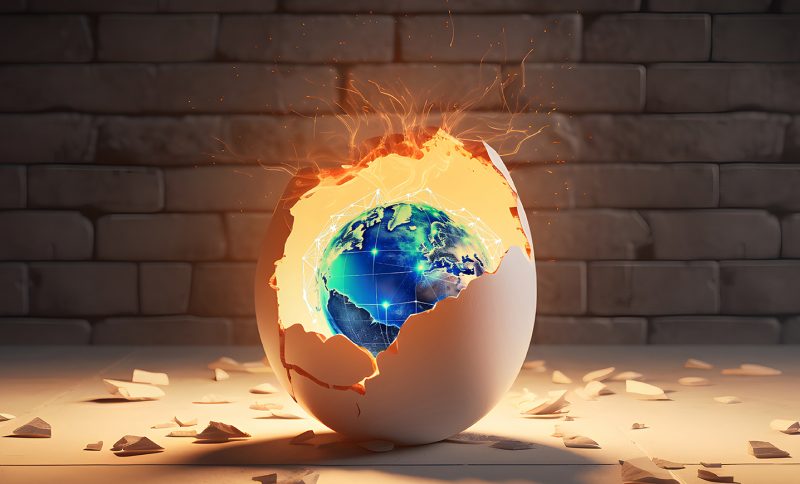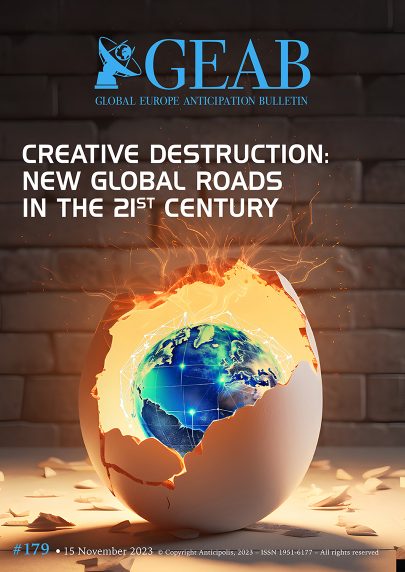GEAB 179

Anticipation means always looking a little further ahead and striving to think the unthinkable. So, when all the signs point to destruction, to collapse, we need to remain clear-headed so as not to overlook the elements of renewal, the signs of creation. Joseph Schumpeter and his theory of creative destruction is useful in this regard. In defining it, he points out that “the new does not grow out of the old, but coexists with the old, competes with it to the point of damaging it”[1].
If the economists are interested in the cycles of innovation in a capitalist system, this theory also applies to the global order of international relations. For over fifteen years, our publication has focused on the transition from the world before to the world after. This historical period must be viewed in terms of the theory of creative destruction: The characteristics of the world before (the result of the Cold War, which the US emerged victorious from) are being destroyed, while the characteristics of the world after (the creation of a multipolar order, in which the Western nations will find themselves on an equal footing with China, India, the BRICS+ and the Middle East, and in which African and Latin American countries will play a significant role) are being created; “any enterprise [here a nation-state or international institution] must, willy-nilly, adapt to it”[2].
The last few weeks and months have been marked by an acceleration of this process, which we describe here as a “fast track”. It is as if, tired of waiting for this transition to follow a slow pace, the geopolitical and geo-economic players had chosen to hasten the need for destruction so as to also hasten the aspects of creation. Yes, at the risk of sounding naive or excessively optimistic, we cannot analyse conflicts without anticipating their resolution, we dare think the unthinkable. The resurgence of tensions in several conflicts, which we began to describe last month as the return of the logics of force, have in common that they stem from the Cold War and therefore from the world before, and their inevitable outcome will be to shape the world after, through a creative destruction.
Therefore, when we analyse the Israeli-Palestinian conflict, we anticipate two potential scenarios: the emergence of new regional dynamics, the first and more likely one in which Israel and Palestine will be fully integrated into a new peaceful and cooperative regional structure; the second, less likely but which cannot be ignored, would see a violent backlash against the Netanyahu government, and an increase in the influence of anti-Zionist ultra-Orthodox Jews (in the sense that they are hostile to the State of Israel), leading to the disappearance of the State of Israel as we know it, in favour of a multi-faith state (see our article Israel-Hamas: The Other Scenario… “Thinking the unthinkable”).
When we analyse the prospect of Ukraine’s integration into the EU, we anticipate the start of a process that will exacerbate the divisions and dysfunctions within the Member States, bringing about the end of the European Union as we know it (see our article “Ukraine 2025: End of the Unilateral European Union”).
In both cases, we have regions with a history stretching back thousands of years that will not be (and indeed probably never will be) destroyed in the true sense of the word. It is their very existence, forged in the second half of the 20th century, that is being called into question, calling for the far-reaching reforms needed to adapt to the new world.
To emphasise the creative dimension, we have also looked at elements that are specific to the post-war world. The creation of new trade routes (which include not only the transport of goods but also wider economic cooperation and exchanges), with INSTC and IMEC at the forefront. They put back, at the centre of the world map, players wrongly judged to be of secondary importance when we limit ourselves to the Sino-American rivalry: the EU, Russia, Iran, Saudi Arabia, the UAE and India. They are intended to replace the historic routes via the Suez Canal, reinforcing the multipolar and resilient dimension of the post-creative destruction world (see our article “2030 Middle East: New Epicentre of World Trade (INSTC, IMEC, New Silk Roads…).
The next world routes are the Chinese New Silk Roads. They are intended also to replace the old ones by creating new ones. But with the creation of infrastructure comes the creation of financial dependence, with partner nations dependent on China for large loans. This is a role hitherto played by the IMF, which is losing much of its influence as a result… creative destruction (see our article “China 2030: The Global Public Debt and Chinese Debt Equation”).
The same goes for AI, on which we welcome two renowned authors, one a fiction writer, Grégory Aimar, the other an academic, Mihai Nadin. Both share their thoughts on the potential for AI to take the place of traditional religions and compete with human intelligence, by consuming far more resources… creative destruction (see our articles on these topics).
If we want to project ourselves effectively and realistically into the future, we need to be clear-headed. This means always remembering that nature abhors a vacuum and that every destruction is necessarily followed by a creation.
To read all the articles of this Issue, subscribe.
_______________
[1] Source: Economie.gouv
[2] Words belonging to Joseph Schumpeter.

The conflict will be resolved in the short term and will allow the region to integrate and open up to all its potential. This is what we presented last month, [...]
In our October issue, the GEAB team anticipated Ukraine's medium-term development: As a result, Ukraine's integration into the EU seems rather hypothetical, as it would have to be supported by [...]
The reshaping of the world is reflected in the evolution of trade routes. Global merchandise trade is expected to reach $32.6 billion in 2030, with Asia, Africa and the Middle [...]
With the subprime crisis (2007/2009), the rescue plans for banks and financial institutions reached such dizzying heights that we did not expect to see them again any time soon. Since [...]
Our team is continuing to research and reflect on the impact of artificial intelligence (AI) on our future societies. In doing so, we are seeking to gather a wealth of [...]
Mihai Nadin, Emeritus Ashbel Smith University Professor, University of Texas at Dallas. His career combines engineering, mathematics, digital technology, philosophy, semiotics, theory of mind, and anticipatory systems. He holds advanced [...]
Eurozone: State bankruptcies on the horizon? Stagflation, recession, rising credit costs, unemployment... the negative signals are multiplying for the eurozone economies. As the end of the year approaches, these indicators [...]

Comments